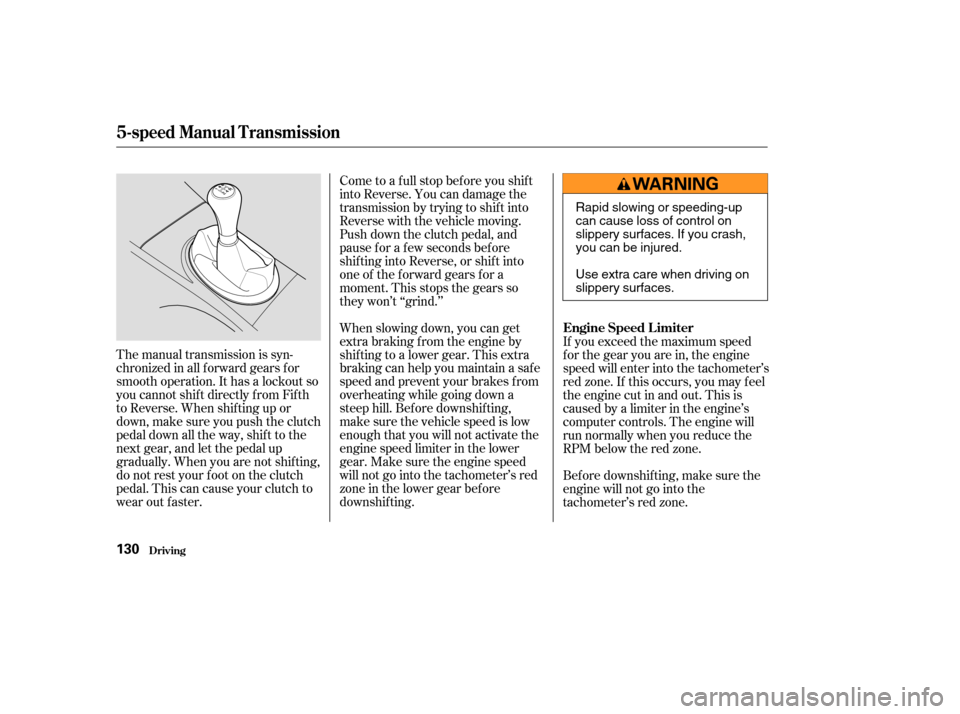2004 HONDA CIVIC HYBRID brakes
[x] Cancel search: brakesPage 57 of 231

The engine can be severely damaged
if this indicator f lashes or stays on
when the engine is running. For
complete inf ormation, see page .This indicator has two f unctions:
If it remains lit af ter you have f ully
released the parking brake while
the engine is running, or if it
comes on while driving, there
could be a problem with the brake
system. For complete inf ormation,
see page . Itcomesonwhenyouturnthe
ignition switch to ON (II). It is a
reminder to check the parking
brake. Driving with the parking
brake not f ully released can
damage the brakes and tires.
See page . If this indicator comes on when the
engine is running, the 12volt battery
is not being charged. For complete
inf ormation, see page . This indicator normally comes on f or
a f ew seconds when you turn the
ignition switch to ON (II), and when
the ignition switch is turned to
START (III). If it comes on at any
other time, there is a problem in the
ABS. If this happens, have your
vehicle checked at a dealer. With
this indicator on, your vehicle still
has normal braking ability but no
anti-lock. For complete inf ormation,
see page .
1.
2.
190
191
141
193
192
If equipped
Charging System
Indicator
L ow Oil Pressure
Indicator Parking Brake
and Brake
System
Indicator
Anti-lock Brake System
(A BS) Indicator
Malf unction Indicator
Lamp
Inst rument s and Cont rols
Instrument Panel
54
U.S. Canada
Page 85 of 231

The outside mirrors are heated to
remove fog and frost. With the
ignition switch in the ON (II)
position, turn on the heaters by
pressing the button. The indicator in
the button comes on as a reminder.
Press the button again to turn the
heaters off.To apply the parking brake, pull the
lever up f ully. To release it, pull up
slightly, push the button, and lower
the lever. The parking brake light on
the instrument panel should go out
when the parking brake is f ully
released (see page ).
54
On Canadian model
Parking Brake
Mirrors, Parking Brake
Inst rument s and Cont rols82
NOTICE:
PARKING BRAKE LEVER
HEATED MIRROR BUTTON
Driving the vehicle with the
parking brake applied can damage the
rear brakes and axles.
Page 113 of 231

Thecruisecontrolmaynotholdthe
set speed when you are going up and
down hills. If your speed increases
going down a hill, use the brakes to
slow down. This will cancel the
cruise control. To resume the set
speed, press the RESUME/accel
button. The CRUISE CONTROL
light on the instrument panel will
come back on.You can increase the set cruising
speed in any of these ways:
Press and hold the RESUME/
accel button. When you reach the
desired cruising speed, release the
button.
Push on the accelerator pedal.
Accelerate to the desired cruising
speed and press the SET/decel
button. You can decrease the set cruising
speed in any of these ways:
Press and hold the SET/decel
button. Release the button when
you reach the desired speed.
To increase your speed in very
small amounts, tap the RESUME/
accel button. Each time you do
this, your vehicle will speed up
about 1 mph (1.6 km/h). To slow down in very small
amounts, tap the SET/decel
button. Each time you do this,
your vehicle will slow down about
1 mph (1.6 km/h).
Tap the brake or clutch pedal
lightly with your f oot. The
CRUISE CONTROL light on the
instrument panel will go out.
When the vehicle slows to the
desired speed, press the SET/
decel button.
Changing the Set Speed
Cruise Control
Comf ort and Convenience Feat ures110
Page 117 of 231

Help assure your vehicle’s f uture
reliability and perf ormance by paying
extra attention to how you drive
during the f irst 600 miles (1,000 km).
During this period:Avoid full-throttle starts and rapid
acceleration.
Avoidhardbrakingforthefirst
200 miles (300 km).
Do not change the oil until the
scheduled maintenance time.
You should also f ollow these re-
commendations with an overhauled
or exchanged engine, or when the
brakes are replaced. We recommend using gasoline
containing detergent additives that
help prevent f uel system and engine
deposits.Use of gasoline with these additives
may adversely af f ect perf ormance,
and cause the Malfunction Indicator
Lamp on your instrument panel to
come on. If this happens, contact
your authorized Honda dealer f or
service.
Your Honda is designed to operate
on unleaded gasoline with a pump
octane number of 86 or higher. Use
of a lower octane gasoline can cause
occasional metallic knoking noises in
the engine and will result in
decreased engine perf ormance.
Using gasoline containing lead will
damage your vehicle’s emissions
controls. This contributes to air
pollution.
In addition, in order to maintain good
perf ormance, f uel economy, and
emissions control, we strongly
recommend, in areas where it is
available, the use of gasoline that
does NOT contain manganese-based
f uel additives such as MMT.
If you notice any undesirable
operating symptoms, try another
service station or switch to another
brand of gasoline. Some gasoline today is blended with
oxygenates such as ethanol or
MTBE. Your vehicle is designed to
operate on oxygenated gasoline
containing up to 10 percent ethanol
by volume and up to 15 percent
MTBE by volume. Do not use
gasoline containing methanol. For f urther important f uel-related
inf ormation, please ref er to your
Quick Start Guide.
Break-in Period, Gasoline T ype
Bef ore Driving
Break-in Period
Gasoline Type
114
Page 125 of 231

Some examples are:Raising your vehicle with an
af termarket suspension kit can
af f ect the handling and stability.
Af termarket wheels, because they
are a universal design, can cause
excessive stress on suspension
components. Larger or smaller wheels and tires
can interf ere with the operation of
your vehicle’s anti-lock brakes and
other systems.
Do not modif y your steering wheel
or any other part of your
Supplemental Restraint System.
Modif ications could make the
system inef f ective. See the saf ety
precautions on page .
Removing parts f rom your vehicle,
or replacing components with non-
Honda (af termarket) components
could seriously af f ect your vehicle’s
handling, stability, and reliability.
Lowering your vehicle with an
aftermarket suspension kit that
signif icantly reduces ground
clearance can allow the
undercarriage to hit speed bumps
or other raised objects, which
could cause the airbags to deploy. If you plan to modif y your vehicle,
consult your Honda dealer. Improperly
replacing or covering f ront seat-
back covers can prevent your side
airbags f rom inf lating during a
collision.
28
Bef ore Driving
Modif ying Your Vehicle Additional Saf ety Precaution
A ccessories and Modif ications
Do not cover or replace f ront seat -
back covers wit hout consult ing aHonda dealer.
122
Page 130 of 231

This section gives you tips on
starting the engine under various
conditions, and how to operate the
5-speed manual and automatic
transmissions. It also includes impor-
tant inf ormation on parking your
vehicle, and the braking system.........................
Preparing to Drive .128
.......................
Starting the Engine .129
....
5-speed Manual Transmission . 130
.
Automatic Transmission (CVT) . 133
...........................................
Parking .139
.............................
Braking System .140
...............
Anti-lock Brakes (ABS) . 141
...........................
Towing a Trailer .142
Driving
Driving127
Page 133 of 231

The manual transmission is syn-
chronizedinallforwardgearsfor
smooth operation. It has a lockout so
you cannot shift directly from Fifth
to Reverse. When shif ting up or
down,makesureyoupushtheclutch
pedal down all the way, shift to the
next gear, and let the pedal up
gradually. When you are not shif ting,
do not rest your f oot on the clutch
pedal. This can cause your clutch to
wear out faster.Come to a full stop before you shift
into Reverse. You can damage the
transmission by trying to shif t into
Reverse with the vehicle moving.
Push down the clutch pedal, and
pause f or a f ew seconds bef ore
shif ting into Reverse, or shif t into
one of the f orward gears f or a
moment. This stops the gears so
they won’t ‘‘grind.’’
When slowing down, you can get
extra braking f rom the engine by
shifting to a lower gear. This extra
braking can help you maintain a safe
speed and prevent your brakes f rom
overheating while going down a
steep hill. Bef ore downshif ting,
make sure the vehicle speed is low
enough that you will not activate the
engine speed limiter in the lower
gear. Make sure the engine speed
will not go into the tachometer’s red
zone in the lower gear bef ore
downshif ting.
If you exceed the maximum speed
f or the gear you are in, the engine
speed will enter into the tachometer’s
red zone. If this occurs, you may f eel
the engine cut in and out. This is
caused by a limiter in the engine’s
computer controls. The engine will
run normally when you reduce the
RPM below the red zone.
Bef ore downshif ting, make sure the
engine will not go into the
tachometer’s red zone.
5-speed Manual T ransmission
Driving
Engine Speed L imiter
130
Rapid slowing or speeding-up
can cause loss of control on
slippery surfaces. If you crash,
you can be injured.
Use extra care when driving on
slippery surfaces.
Page 134 of 231

To maximize f uel economy, your
Civic Hybrid has an Auto Idle Stop
f unction. Under certain conditions,
the engine will shut of f when you
come to a stop. Those conditions are:The engine coolant is nearly up to
normal operating temperature.
The vehicle’s speed is below 19
mph (30 km/h) and you are
pressing on the brake pedal to
come to a stop.
You depress the clutch pedal.
You are not pressing on the
accelerator pedal.
The IMA battery is charged
enough to operate the system. The Auto Idle Stop f unction may not
activate if the IMA battery
temperature is too hot or too cold. During Auto Idle Stop, the IMA
charge and power brake vacuum
reserve is monitored by the system.
If either drops below a desired level,
and the shif t lever is in Neutral, the
engine will restart so it can recharge
the IMA battery or replenish the
vacuum supply.
The ECON mode is selected, and
the outside temperature is above
f reezing, or the f an speed control
dial is off (see page ).
There is adequate vacuum reserve
f or the power brakes.
When these conditions are met, the
engine will shut of f as you come to a
stop. It will start again automatically
when you depress the clutch pedal
f ully and move the shif t lever to f irst
gear. There is no need to start the
engine with the ignition switch.
It is recommended that you move
the shift lever to Neutral and remove
your f oot f rom the clutch pedal while
you are stopped. Sitting with the
clutch pedal depressed and the shif t
lever in gear will cause the engine to
continue running, def eating the f uel
economy benef its of the Auto Idle
Stop f unction. 89
5-speed Manual T ransmission
Auto Idle Stop
Driving131